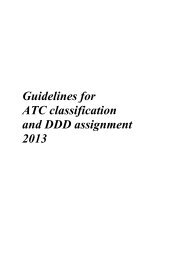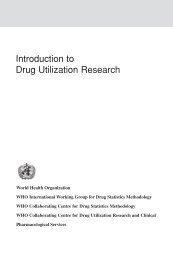Download - WHOCC
Download - WHOCC
Download - WHOCC
Create successful ePaper yourself
Turn your PDF publications into a flip-book with our unique Google optimized e-Paper software.
2.2 Classification of plain preparations<br />
Plain preparations are defined as:<br />
Preparations containing one active component (including stereoisomeric mixtures), and<br />
additional substances intended to<br />
- increase the stability of the preparations (e.g. acetylsalicylic acid + ascorbic acid), or<br />
- increase the duration of the effect (e.g. depot formulations), or<br />
- increase the absorption of the active component (e.g. different solvents in<br />
dermatologicals).<br />
Different salts of the active ingredient are usually given one and the same 5th level ATCvet<br />
code, but prodrugs and stereoisomers with differing pharmacological activity may be assigned<br />
separate 5th level codes.<br />
2.3 Classification of combination products<br />
Products containing two or more active components are classified as combination products in<br />
accordance with the principles of the ATC system. In general, the main therapeutic use decides<br />
which ATCvet code is to be used.<br />
Combination products are classified according to two main principles:<br />
1. Combination products containing two or more active components not belonging to the same<br />
therapeutic 4th level group are classified using 50-series codes.<br />
Example:<br />
QJ01AA06 oxytetracycline (plain)<br />
QJ01AA56 oxytetracycline, combinations<br />
Combination products with the same main active ingredient are usually given the same<br />
ATCvet code. Thus oxytetracycline + flunixin and oxytetracycline + neomycin are both<br />
assigned the code QJ01AA56.<br />
Packages comprising two or more different medicinal products marketed under a common<br />
brand name are also considered as combination products.<br />
E.g.: Sotalol tablets and aspirin tablets in one combination package is classified in<br />
QC07AA57 sotalol, combinations.<br />
2. Combination products containing two or more active ingredients belonging to the same<br />
therapeutic 4th level group are classified using the 5th level codes 20 or 30.<br />
Example:<br />
QJ01CA Penicillins with extended spectrum<br />
QJ01CA02 pivampicillin<br />
QJ01CA08 pivmecillinam<br />
QJ01CA20 combinations<br />
16





